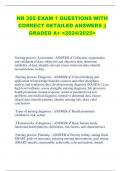NR 302 EXAM 1 QUESTIONS WITH
CORRECT DETAILED ANSWERS ||
GRADED A+ <2024/2025>
Nursing process: Assessment - ANSWER ✔ Collection, organization
and validation of data; subjective and objective data; determine
reliability of data; identify relevant versus irrelevant data; identify
inconsistencies in data
Nursing process: Diagnosis - ANSWER ✔ Critical thinking and
application of knowledge from the sciences and other disciplines,
analyze and synthesize data, develop nursing diagnosis (NANDA-1 List,
high level wellness, assess strengths, nursing diagnosis, life processes,
health promotion, human response, actual or potential (risk for)
problems, not medical diagnosis, normal vs abnormal data, cluster
related data, identify patterns, identify missing info, draw valid
conclusions
Types of nursing diagnoses - ANSWER ✔ Health promotion
(readiness), risk, actual
3 Frameworks of diagnoses - ANSWER ✔ Basic human needs,
functional health patterns; definitions, risk factors, and characteristics
Nursing process: Planning - ANSWER ✔ Priority setting, stating client
SMART goals or outcomes, selecting nursing interventions, goal setting
(SMART specific, measurable, achievable, relevant/realistic, timed)
, Nursing process: Implementation - ANSWER ✔ Putting nursing
interventions into action
Nursing process: Evaluation - ANSWER ✔ Comparing client to stated
goals or outcomes
Focus of nursing process - ANSWER ✔ Basis for planing and
implementing
Types of nursing diagnosis: Actual - ANSWER ✔ Diagnosis found in
the nursing diagnosis handbook, will always be written with the
diagnosis followed by RT and then AEB
Type of nursing diagnosis: Risk - ANSWER ✔ No related factors,
potential problem (problem is not yet present), identify risk factors the
predispose the individual to a potential problem. Ex: Risk for---as
evidenced by----(risk factors)
Type of nursing diagnosis: Health Promotion - ANSWER ✔ No related
factors, defining characteristics are provided as evidence of the desire on
the part of the patient to improve his/her current health state. Ex:
Readiness for---as evidenced by---(defining characteristics)
SMART goal - ANSWER ✔ Specific, measurable, achievable,
realistic/relevant and time specific
4 Basic techniques of assessment - ANSWER ✔ Inspection, palpation,
percussion, ausculation
Order change with abdominal assessment - ANSWER ✔ Inspection,
ausculation, percussion, palpation
, Palpation: - ANSWER ✔ Dorsal (back of hand) is for temperature, fine
sensations (pulse, edema, tumors, lesions, lymph nodes, organs) are felt
with the fingertips and pads of fingers, vibrations (thrills, tactile,
fremitus) are felt using the metacarpopalangeal joint, palmar surface and
ulnar surface. Measure size, shape, location, mobility, position,
vibrations, temperature, texture, moisture, tenderness and edema.
Light-Deep palpation - ANSWER ✔ Light 1cm, moderate 1-2 cm, deep
2-4 cm
Direct percussion - ANSWER ✔ Tapping the body with the fingertips
of the dominant hand. Used to assess sinuses of an adult and thorax of
infant.
Blunt percussion - ANSWER ✔ Place palm of the non-dominant hand
flat against the body, "punch" flat hand with dominant hand. Used for
assessing pain and tenderness in gallbladder, liver, kidney
(costovertebral angle tenderness, kidney infection)
Indirect percussion - ANSWER ✔ Pleximeter (non-dominant middle
finger, makes firm contact with the body ex: lung, abdomen) and plexor
finger delivers 2 sharp strikes (use tip of finger NOT finger pad to
deliver blow)
Characteristics of percussion sounds - ANSWER ✔ Intensity of
amplitude, pitch or frequency ( high, low), duration and quality
Kinds of percussion sounds: Tympany - ANSWER ✔ Loud, high-
pitched, medium, drum-like. Organ filled with air-intestines, stomach.
Kinds of percussion sounds: Resonance - ANSWER ✔ Loud, low-
pitched, long. Lungs.
, Kinds of percussion sounds: Hyperresonance - ANSWER ✔ Loud, low-
pitched, longer. Lungs (Air trapped, emphysema)
Kinds of percussion sounds: Dullness - ANSWER ✔ High-pitched, soft,
short. Solid organs (liver, spleen, tumors)
Kinds of percussion sounds: Flatness - ANSWER ✔ High-pitched, very
soft, very short. Solid tissue (muscle, bone)
Ausculation characteristics - ANSWER ✔ Intensity, pitch (high
pitched-diaphragm of stethoscope, breathe sounds, heart sounds, bowel
sounds) (low-pitched-bell of stethoscope, abnormal heart sounds,
vascular sounds; bruits), duration and quality.
Doppler Stethoscope - ANSWER ✔ Doppler ultrasonic stethoscope, to
hear peripheral pulse
Ophthalmoscope - ANSWER ✔ For looking at the eyes
Otoscope - ANSWER ✔ For looking at ears and nose
Gomiometer - ANSWER ✔ Used the measure the degree of joint
flexion and extension, the circular center is placed at the joint and the
arms are moved outward to measure the flexion and extension of the
extremities
Wood's lamp - ANSWER ✔ Used to see fungal infections, the light is
shown onto the skin in a dark room and fungi will glow
Safety and comfortable environment factors - ANSWER ✔ Warm,
private, distraction-free exam room; good overhead lighting with a
portable lamp; clean, firm exam surface; knowledge of the client's




